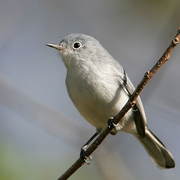Blue-gray Gnatcatcher
Polioptila
caerulea
Passeriformes
Members of this diverse group make up more than half of the bird species worldwide. Most are small. However their brains are relatively large and their learning abilities are greater than those of most other birds. Passerine birds are divided into two suborders, the suboscines and the oscines. Oscines are capable of more complex song, and are considered the true songbirds. In Washington, the tyrant flycatchers are the only suboscines; the remaining 27 families are oscines.
Sylviidae
Currently classified as a subgroup of a large family that also includes the Old World warblers, the gnatcatchers and gnatwrens of the Americas are very small, active birds, with long tails that they often hold cocked. They are typically in constant motion, flicking their tails and flashing their wings as they climb about in the foliage. Most are permanent residents in warm climates, but the Blue-gray Gnatcatcher migrates into more northerly areas to breed and reaches Washington as a rare vagrant. Gnatcatchers have slender bills and eat mostly insects. They generally inhabit brushy areas including streamside thickets, desert scrub, and sagebrush. Most species are monogamous, and both sexes help incubate and feed the young.
General Description
Casual in fall and winter (October'February) at low elevations in western Washington, one May'June record from Yakima County and one September record from Walla Walla (Walla Walla County).
North American Range Map




